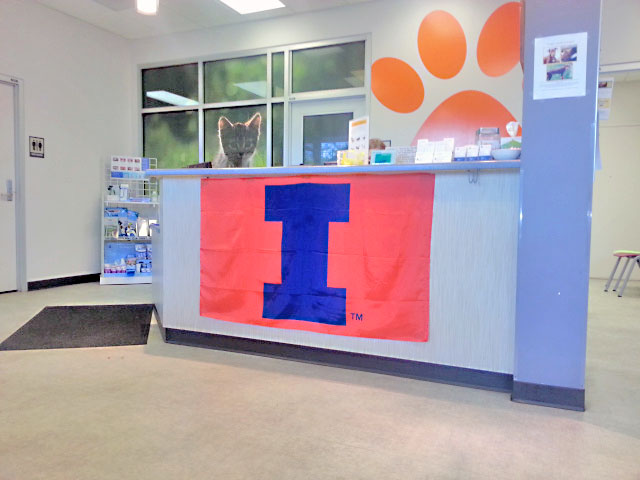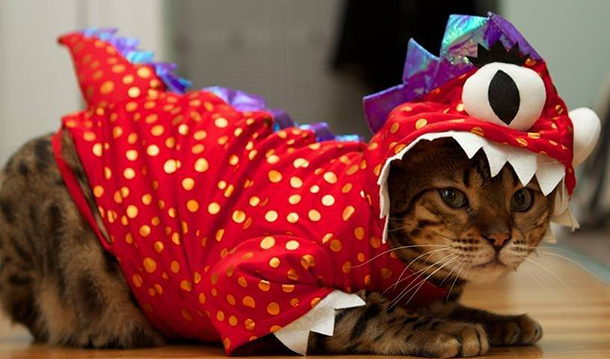Our Blog
IMPORTANT UPDATE: Chicago Kennel Cough Outbreak
 In recent weeks we have seen a large number of coughing dogs here in Chicago. Most of the affected dogs have a history of frequenting day care, boarding facilities, and dog parks. At this time I recommend avoiding these facilities to help protect your dog, even if he/she has been vaccinated for “canine cough.”
In recent weeks we have seen a large number of coughing dogs here in Chicago. Most of the affected dogs have a history of frequenting day care, boarding facilities, and dog parks. At this time I recommend avoiding these facilities to help protect your dog, even if he/she has been vaccinated for “canine cough.”
Why isn’t vaccination sufficient protection? Let me explain a little about canine cough.
“Canine cough” (also called “kennel cough”) is a broad term to describe infectious tracheobronchitis. This highly contagious condition results in inflammation of the trachea and bronchus. Many viruses and bacteria can result in canine cough. Currently the intra-nasal vaccine recommended for dogs here at the Medical District Veterinary Clinic covers the three most common causes of canine cough: Bordetella (bacteria), Parainfluenza (virus), and Adenovirus (virus).
However, early test results from patients in this outbreak point to an underlying culprit of canine influenza (flu). There is a vaccine for canine influenza on the market, but it has not been widely used or recommended because of the low risk of canine influenza.
Most cases start with a mild cough, which eventually progresses to a loud, honking cough. Some pets have decreased appetite, depression, and fever. We have seen a number of dogs develop a secondary pneumonia. If your pet is showing any of these signs, please have your pet seen.
Due to the outbreak I recommend avoiding any direct dog-to-dog contact and vaccinating dogs at high risk, such as those that attend day care, boarding, grooming, or dog parks and dogs that live in high rises. Although the vaccine does not 100% prevent infection, it should reduce the number of affected dogs. The canine influenza virus can survive 48 hours on hard surfaces and 24 hours on clothing, thus it is very important to be cautious in elevators, hallways, and dog relief stations.
Dogs need a booster two to four weeks after the initial vaccination. Dogs are not considered protected until 14 days after the second vaccine. The vaccination lasts one year and must be given annually thereafter. We do not recommend vaccinating dogs that have been infected until at least four weeks after the infection has cleared. Not all dogs may need the vaccine.
Please call the Medical District Veterinary Clinic at Illinois with any questions: 312-226-2588.
ANOTHER REASON TO SMILE: Dental Discount Extended Through March
SMILE! Pet Dental Health Month Means Discounts
 A healthy smile means a healthy pet.
A healthy smile means a healthy pet.
We’re celebrating Pet Dental Health Month with a 10% discount on all dental services throughout the month of February. Bonus: UIC students, faculty and staff (with current I-cards) will receive a 15% dental discount during this time.
Call for an appointment today.
Come Next Saturday for Coffee, Cocoa & Pet Nutrition Advice
 Stop by on Saturday, January 24, between 11:00 am and 2:00 pm, to help us celebrate our revamped digs.
Stop by on Saturday, January 24, between 11:00 am and 2:00 pm, to help us celebrate our revamped digs.
- Enjoy a coffee/hot cocoa bar (with lots of yummy toppings)
- Bring your pet in for a complimentary body conditioning score
- Get advice on pet nutrition
- Tour our facilities
- Visit with our staff
Remember to enter through our new Suite 100 entrance.
THE NAUGHT & NICE LIST: Tips for a Happy & Pet-Safe Holiday
 The holiday season is a feast for the senses — bright lights and candles, mouthwatering treats and shiny, festive decor — which means it’s also filled with potentially hazardous temptations for your furry friends.
The holiday season is a feast for the senses — bright lights and candles, mouthwatering treats and shiny, festive decor — which means it’s also filled with potentially hazardous temptations for your furry friends.
So before you extend the holiday cheer to your animal companions, check out our “Naughty and Nice” list for tips on creating a happy and pet-safe holiday.
Naughty (Keep these out paw’s reach)
- Lilies
- Poinsettias
- Tinsel
- Lit candles
- Shiny, breakable ornaments
- Chocolate
- Grapes/raisins
- Macademia nuts
- Onions
- Fatty meat, stuffing or gravy
- Bread or bread dough
- Snow melt or salt (in case we get any of that white stuff they’re predicting)
Nice (Sure bets for safely sharing the holiday spirit)
- An active toy
- A soft, warm pet bed or blanket
- Lean turkey meat
- Cat- or dog-specific treats (much safer than people food)
- Extra play or snuggle time with you
Holiday Hours
We will be:
- Open from 8-12 pm on 12/24
- Closed on 12/25
- Closed on 12/28
- Open from 8-12 pm on 12/31
- Closed on 1/1
For emergency service during the holidays, contact VSC at Illinois at 312.226.3641.
Wishing you and your animal companions a healthy and happy holiday season!
HAVE A HAPPY AND PET-SAFE THANKSGIVING
 At Thanksgiving we look forward to sharing a feast with our families and friends. But should that celebration include our animal companions?
At Thanksgiving we look forward to sharing a feast with our families and friends. But should that celebration include our animal companions?
Probably not.
A typical Thanksgiving meal contains a number of foods that could put your pet’s health in serious danger.
- Onions, grapes/raisins and chocolate all contains ingredients that are toxic to cats and dogs.
- Rich fatty foods like dark meat turkey or gravy can put your pet at risk for pancreatitis.
- Bread and other yeast-filled items can cause bloat in dogs and should be kept out of paw’s reach.
- And as tempting as it may be to throw Fido a bone, doing so could cause choking or risk internal damage if a sharp piece is swallowed.
- The safest treat is a small amount of lean white meat turkey.
If your pet is nervous around strangers (or if your guests are nervous around pets), consider putting your furry friend in a separate room with a comfy blanket or pet bed. You might even let them tune into the Puppy Bowl.
Once the meal is over, show your pet some love with a long walk or a game of fetch. They’ll enjoy the extra activity and you’ll feel less guilty about the second piece of pie.
Thank you for choosing Medical District Veterinary Clinic at Illinois as your pet’s health and wellness home.
Happy Thanksgiving to all of our furry friends and their humans.
THE FALL FROLIC COSTUME CONTEST NEEDS YOUR VOTE
Help Us Choose the Paws-Down Winner!
 We have 11 furrtastic entries in our Fall Frolic Costume Photo Contest and we need your help choosing a winner. Just cast your vote with a “like.” The pet with the largest number of unique “likes” will get their paws on some serious swag.
We have 11 furrtastic entries in our Fall Frolic Costume Photo Contest and we need your help choosing a winner. Just cast your vote with a “like.” The pet with the largest number of unique “likes” will get their paws on some serious swag.
And don’t forget to share with your friends.
THE FALL FROLIC IS BACK BY POPULAR DEMAND
Join us on Saturday, November 1 from noon to 3 pm for the 2014 Furry Friends Fall Frolic.
- Dress your pets in their spooktacular best.
- Enjoy tricks and treats for pets and their humans.
- Get a free digital pet portrait and swag bag.
- All costumed pets in attendance with be entered into our Facebook Costume contest.
- Find out more on the Fall Frolic event page.
Help us make the Fall Frolic, more social:
RABIES AWARENESS: PREVENTION IS KEY

According to the Centers for Disease Control and Prevention, more than 55,000 people die each year worldwide due to the rabies virus. Although most of these deaths occur outside of the United States, it is still important to understand the seriousness this disease poses to humans and pets.
September 28 has been declared “World Rabies Day” to help raise awareness about this potentially fatal virus. Dr. Gail Scherba, a veterinary virologist at the University of Illinois College of Veterinary Medicine in Urbana, explains what rabies is and how to keep humans and pets protected.
“Rabies is a zoonotic virus, meaning it can be spread from animals to people. It is most often spread by a bite wound. Once saliva from the infected animal enters the body, the virus begins to invade nerve endings and then spreads to the central nervous system,” says Dr. Scherba. The virus replicates in the central nervous system, and from there will begin to infect the body’s peripheral organs.
The rabies virus targets infection of neurons as well as secretory epithelium (salivary glands). Once the virus has made its way into the salivary gland, the virus can be shed in the saliva and can be transmitted via a bite wound.
According to Dr. Scherba, the incubation period of rabies–the time between exposure to the virus and when the first clinical signs appear–varies depending on species. A typical incubation period for rabies is 10 to 90 days.
Dr. Scherba explains that there are two clinical forms of rabies, “furious” and “dumb.” In the furious form, the animal’s behavior can be altered, and the animal may become aggressive. This form of rabies also causes paralysis of the laryngeal muscles. The afflicted animal is unable to swallow, and often foams at the mouth from excessive salivation.
The dumb form manifests itself as a severe depression and the animal can have a lack of coordination and paralysis. According to Dr. Scherba, both forms of rabies can cause what is called “fatal encephalitis”–inflammation of the brain–in this case due to the virus. The encephalitis causes the animal to have seizures; paralysis will progressively worsen. The animal will eventually go into a coma, which then leads to death.
In the U.S., rabies virus is spread by wild animals, including bats, skunks, foxes, and raccoons. People that are at a higher risk for contracting the rabies virus (veterinarians, researchers, wildlife biologists, people who travel to areas where rabies is prevalent, and so on) should seek prophylactic vaccination.
According to Dr. Scherba, the incidence of rabies in the United States in humans has been declining. In 2012 there was only one confirmed case of a person having rabies in the U.S., which was down from six cases the previous year.
Dr. Scherba emphasizes the importance of having a pet up to date on their rabies vaccine. “If an unvaccinated pet is bitten by a rabid animal, the pet should be euthanized to prevent the spread of rabies,” she says.
If a vaccinated cat or dog is bitten by a rabid animal, the pet would need to be revaccinated for rabies immediately and also be under a strict 45-day observation. Unfortunately, once clinical signs are observed, there is no treatment for animals with rabies; the disease is fatal.
“If a person is bitten by suspected rabid animal, it is important to report the bite to the local health department immediately,” says Dr. Scherba. Regardless of the vaccination status of the animal, the pet should remain under the observation of the owner for 10 days to detect clinical signs of rabies.
A person who is bitten by an animal that is suspected to have rabies should seek medical treatment immediately and may receive the rabies vaccination series. “Rabies is much easier to prevent than it is to treat, so every effort should be made to prevent this fatal virus in humans and pets,” says Dr. Scherba.
For more information about rabies, speak with your local veterinarian.
WE ARE FEATURED ON BTN LiveBIG!
 We are honored to have our clinic and new medical director, Dr. Sullivan, featured on the Big Ten Network’s blog, BTN LiveBIG!. Read the article to learn more about Dr. Sullivan and the teaching that happens in our clinic. You’ll also learn about a high-tech feature installed within our surgical suite! View the full article.
We are honored to have our clinic and new medical director, Dr. Sullivan, featured on the Big Ten Network’s blog, BTN LiveBIG!. Read the article to learn more about Dr. Sullivan and the teaching that happens in our clinic. You’ll also learn about a high-tech feature installed within our surgical suite! View the full article.

